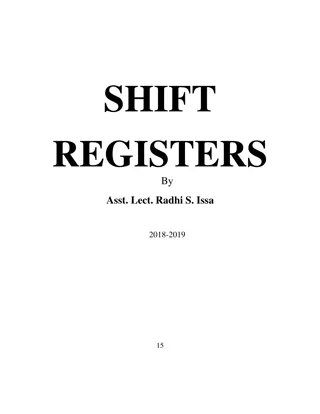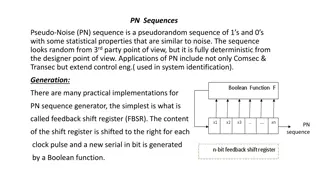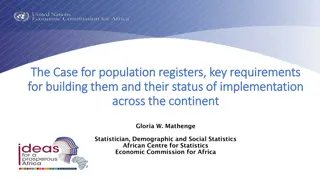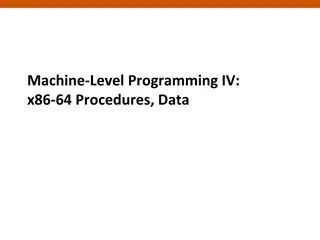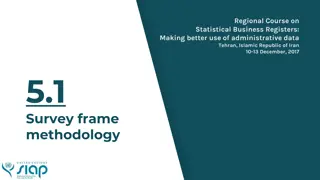Understanding Quality Dimensions in Statistical Business Registers
Quality in statistical business registers encompasses dimensions such as relevance, accuracy, timeliness, accessibility, comparability, and coherence. The United Nations provides guidance on quality frameworks for official statistics, emphasizing the importance of tailoring quality assurance policies to each country's National Statistical System. Challenges in SBR quality include dependence on data from external administrative sources.
Download Presentation

Please find below an Image/Link to download the presentation.
The content on the website is provided AS IS for your information and personal use only. It may not be sold, licensed, or shared on other websites without obtaining consent from the author. Download presentation by click this link. If you encounter any issues during the download, it is possible that the publisher has removed the file from their server.
E N D
Presentation Transcript
Regional Course on Statistical Business Registers: Making better use of administrative data Tehran, Islamic Republic of Iran 10-13 December, 2017 6.1 Quality improvement
HOW DO WE DEFINE QUALITY? Quality of official statistics is considered a multi-dimensional concept. Quality dimensions include things like timeliness, relevance and accessibility.
HOW DO WE DEFINE QUALITY? UNSD provides general guidance on quality frameworks for official statistics with its Generic National Quality Assurance Framework, but every country should have their own detailed quality assurance policy tailored to its National Statistical System.
SBR QUALITY With regards to SBR quality, we will discuss the following six dimensions: Relevance Accuracy Timeliness Accessibility Comparability Coherence
SBR QUALITY Relevance The SBR contains the units and characteristics necessary to support the production of statistics according to user needs. Accuracy The information contained in the SBR is correct.
SBR QUALITY Timeliness The data provide as current a picture of the real world as possible. Users know when to expect frozen frames and SBR statistics. Accessibility For internal users, this means access to microdata via direct access. For external users, this means access to aggregate tables.
SBR QUALITY Comparability The concepts and methods used to maintain units in the SBR do not change across regions or over time. Coherence Internal coherence refers to coherence of units and and characteristics within the SBR and coherence with other registers concerns maintaining links (e.g., with a common ID).
SBR QUALITY One of the main challenges for SBR quality is that it is highly dependent on the quality of data from administrative sources, which are outside the control of the National Statistics Office.
SBR QUALITY Since the SBR brings together information from a variety of sources, quality considerations will not be the same for all units and characteristics.
SBR QUALITY SBR data should therefore be split into subsets and quality indicators should be developed for each. Subsets should be based on: Data source Unit type and/or Group of characteristics
SBR IMPROVEMENT SURVEYS Two purposes: Error detection and filling in missing values Measuring the accuracy of SBR data
QUALITY ASSESSMENT In addition to SBR improvement surveys, quality of SBR data can be measured in a number of ways
QUALITY ASSESSMENT Comparison with other sources Comparing SBR data with data available from external sources to see if values are sufficiently close (compliance). Internal consistency Checking if values are plausible based on other characteristics of the unit or theoretical constraints.
QUALITY ASSESSMENT Comparison with past values Comparing current values to past values to see if their change over time is plausible. Source and recency of data Checking how recently values were updated and which sources and methods were used.
QUALITY INDICATORS Quality indicators can be calculated for SBR: Inputs Processes Outputs
INPUT INDICATORS - EXAMPLES Time lag Difference between the date data are available and their reference period. Missing value rate Number of missing values for each characteristic of supplied data.
PROCESS INDICATORS - EXAMPLES Number of new records Comparison of unit creations over time can help identify problems in supply. Active status concordance rate Number of active units in both the source and the SBR out of the number of units in both.
OUTPUT INDICATORS - EXAMPLES Time lag for survey frames Time lag between the reference period for a survey and the delivery of the survey frame. Error rates For example, percentage of units with wrong contact information or activity code.
SBR QUALITY POLICY An SBR quality policy lays out: How quality is defined and measured for your SBR What information about SBR quality will be communicated to users The decision to initiate a quality improvement programme
SBR QUALITY REPORTS A good practice is to communicate with users about the quality of the SBR data using (ideally sub-annual) quality reports.
SBR QUALITY REPORTS Quality reports should communicate: An assessment of the quality of the SBR Significant changes that have been made that will affect sampling frames
CASE STUDY: THE NETHERLANDS DATA SOURCE QUALITY CHECKLIST The Netherlands uses a checklist, which includes yes or no questions and numeric indicators, to evaluate data sources according to: General information about the data source The metadata supplied The data itself
CASE STUDY: THE NETHERLANDS DATA SOURCE QUALITY CHECKLIST General information about the data source includes questions such as: Does the data source satisfy information demand? Cost of the data source How punctually can the data source be delivered?
CASE STUDY: THE NETHERLANDS DATA SOURCE QUALITY CHECKLIST Metadata indicators include: Clarity scores for definitions of units and variables Are modified values marked and how?
CASE STUDY: THE NETHERLANDS DATA SOURCE QUALITY CHECKLIST Data indicators include: Percentage of units linked unambiguously Percentage of cells with missing values
CASE STUDY: THE NETHERLANDS DATA SOURCE QUALITY CHECKLIST Only if quality evaluations for each of the three areas are deemed successful can the data source be used.
CASE STUDY: COLOMBIAS QUALITY INDICATORS Colombia has recently proposed using six quality indicators for its SBR data, including: Income precision: ratio of total income by sector in the SBR to the official NSO national accounts data Ratio of the number of units in the SBR for a given year to the number of unique units in the tax register in the same year
REFERENCES This presentation was primarily based on UNECE s Guidelines on Statistical Business Registers, in particular Chapter 10. Other material used: The African Development Bank s Guidelines for Building Statistical Business Registers in Africa Eurostat s Business registers: Recommendations manual UNSD s Report on global status of statistical business register systems Country maps based on Natural Earth data. Presentation template by SlidesCarnival








